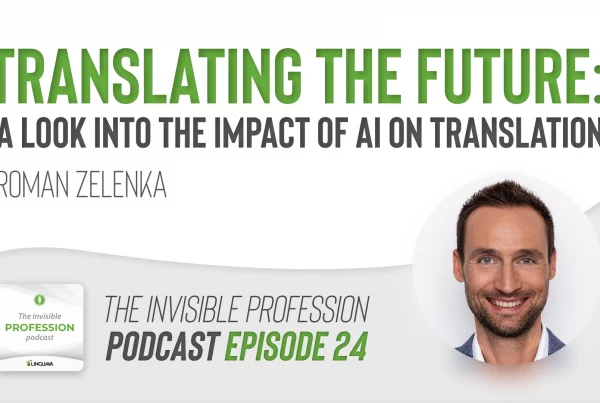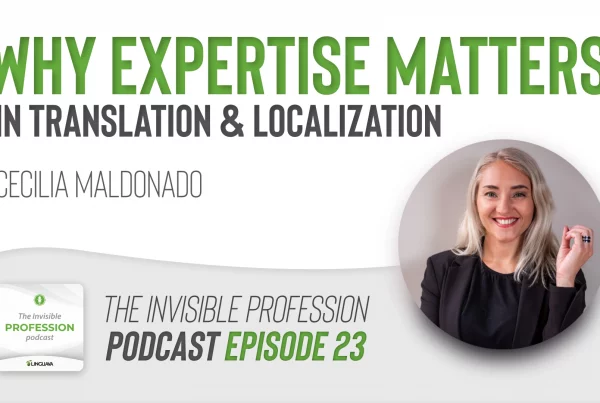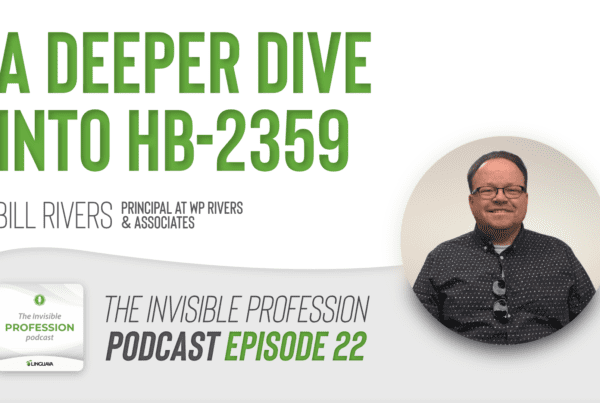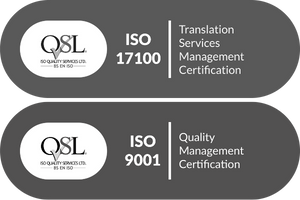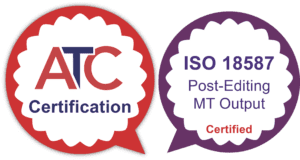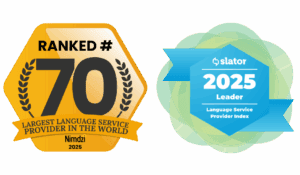In an interview with Corey Axelrod, we continued our celebration of Deaf History Month with a conversation surrounding the range of experiences for the Deaf Community in healthcare settings.
“How do we optimize the patient experience and make them at the center and put their focus or their needs, at the forefront. There are a lot of disparities that the Deaf and Hard of Hearing community faces, that actually shouldn’t be the case… The bottom line is really having a conversation with a patient who is Deaf and Hard of Hearing, asking them what their needs are, accommodating and meeting them where they’re at.”
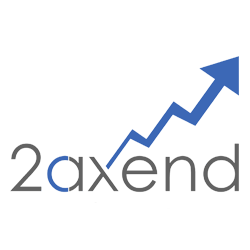
Corey is a passionate social justice advocate and social entrepreneur. As founder and CEO of 2axend, he helps businesses and organizations deliver user-centric experiences for Deaf and Hard of Hearing individuals.
Listen to our podcast on all your favorite platforms here.
Connect with us on your favorite social site:
LinkedIn | Facebook | Instagram
At Linguava, we are dedicated to reducing communication barriers and providing equity to all members of our community through language access services.
If you are interested in learning more about incorporating language access into your business or would like to book a training session, contact us today.
Transcript – The Invisible Profession Podcast Ep. 018
David: [00:00:00] Welcome to the Linguava podcast. The Invisible Profession, were we give you tools, tips, and resources in medical interpretation, and translation to help bring to life our profession and ultimately help improve health outcomes for the limited English proficient and Deaf and Hard of Hearing community. All right, Corey. Thank you so much for, being with us this morning. It’s a real honor to have you here and having this conversation with you. Can you first just share, share with our audience today? Just a little bit about who, you are and, what it is that you do.
Corey: First off, thank you for the opportunity to join this conversation. It’s an essential conversation that we’re having and my name is Corey Axelrod, I’m the founder and CEO of 2axend. We are a strategic [00:01:00] consulting and training firm, and we work with a variety of different organizations and we focus who impacts the Deaf and Hard of Hearing user experience.
In healthcare settings, we focus on accessible planning, inclusive organizational design, risk management, organizational compliance, cultural sensitivity.
David: Excellent. And Corey, what do you see as the typical experience for, the Deaf Community in healthcare settings?
Corey: I’m a Typical, I don’t know if it is the correct word off the top of my head, but we’ve seen a variety of different experiences, some are picture perfect and some are a nightmare, [00:02:00] and that sort of pendulum swing in that range or that spectrum. What I’d like to do is how do we optimize the patient experience and make them at the center and put their focus or their needs, at the forefront. There are a lot of disparities that the Deaf and Hard of Hearing community faces, that actually shouldn’t be the case. And the goal should be pivoting to providing patient centric experiences, and there are so many different elements that comprise that need to be taken into consideration.
The bottom line is really having a conversation with a patient who is Deaf and Hard of Hearing, asking them what their needs are, accommodating and meeting them where they’re at.
David: And I know from from following you on LinkedIn, where I know you, did a survey recently. Is there any insights [00:03:00] that you can share from that survey in regards to patient experience?
Corey: Absolutely, and actually thank you for that question. We’re still in the process of collecting that data. And based on the early review, the consensus is there’s a lot of improvement or a lot of opportunity for improvement or the need for improvement. And I think it really presents, it really paints a picture of do healthcare organizations really understand what it means to provide patient centric experiences to Deaf and Hard of Hearing individuals? Not only individuals who sign, but also individuals who don’t sign. The Deaf and Hard of Hearing community is vast. We have 48 million Deaf and Hard of Hearing individuals in the United States. We have a [00:04:00] population that uses American Sign Language as their primary preferred language, all the way to the other side of the spectrum who don’t use sign language, or don’t know sign language and spoken language is their preferred mode of communication. That whole picture presents a lot of challenges that different individuals encounter, and I’m really looking forward to completing that collection of data and the responses from the community and then we’ll publish it.
The bottom line is that there are opportunities and we’ve already seen that based on the responses that we have got.
David: Yeah, we’ll be looking forward to hearing and seeing some of that data that you’re able to share with with us as well. Thank you for doing a survey like that, it’s really helpful. Thinking about where we’ve come from, I think it’s always important to look back at, the history as well and, to see how [00:05:00] we have evolved or how we have changed over time. When you look back at the last, say 50 years, how have you seen the, access to health care change or, evolve over time for the Deaf and Hard of Hearing community?
Corey: Another great question. I think about my own firsthand experience, seeing my grandparents in the hospital and their level of access. Now I’m fourth generation Deaf, I should say. And I remember when I was younger, the Americans with Disabilities Act was enacted into law, or just passed. And my grandparents had a lot of trials and tribulations and frustrations trying to get access to an interpreter.
You’re talking about the early [00:06:00] nineties before this law was passed. And even when that law was passed things didn’t just correct themselves. A lot of people aren’t well versed in the legal requirements, or the legalese, and now fast forward to 2022, we’re still seeing challenges in the healthcare system, just with basic adherence to the law, with the provisions of interpreters – or providing of interpreters – that right there, not only that, but providing interpreters. It’s also what we’re seeing is that there’s a shift from in-person interpreters to providing interpreters through video technology remotely. There are advantaged, advantages to providing remote interpreting because more often than not it’s on demand. But the question is, does technology always
work, and does it [00:07:00] meet the needs of the Deaf and Hard of Hearing individuals who are patients? There are so many different factors that we need to take into consideration, and sometimes those decisions are made for Deaf and Hard of Hearing individuals without their input, and that’s a concern. And I also want to add that with the COVID-19 pandemic, it’s changed everything.
And now we’re seeing telehealth skyrocket and become popular. And telehealth, I use it personally, and for myself, for my two boys, who are now 23 months old. And my wife and I have used it and there’s a lot of advantages to it. However, there’s also some disadvantages that are there often when we don’t have.
an interpreter as a part of that actual dialogue. [00:08:00] I think about the platform, the design of those platforms, often accessibility is not considered a quote unquote baked in part of the developmental phase of that platform. As a result, after the fact, they’re trying to retrofit and right their wrongs and include third party software, how do we, include what, not even interpreters, but also captioning in that third party software?
I wish it was baked in from the beginning. And so that’s a missed opportunity, unfortunately. And so I think the Deaf community often gets left behind. So technology is progressing and advancing, but the needs and Deaf and Hard of Hearing individuals aren’t considered from the beginning. So oftentimes we’re seeing reactive [00:09:00] measurements to respond to an issue.
Oh, we’re not, we’re inaccessible, this is what we need to do. And oftentimes that’s where we get left out. So yes, in the 30, 40, 50 years we’ve seen a lot of, or we seen some progress, but at this day in 2022, we should not be looking at, the law as the standard or the status quo.
It should be looked at ADA and other civil rights acts as more of the minimum standard. And building from there. And how do we elevate and how do we focus on the spirit of the law rather than the letter of the law?
David: Yeah very, well said, and I want to focus and pivot slightly to the role of, Deaf interpreters in, healthcare settings as, as [00:10:00] well.
How have you seen that the Deaf interpreter community is incorporated into the medical team, and what do you see as the main benefits for working with Deaf interpreters?
Corey: I think back to a time with my father specifically, when he was alive, and he passed away almost 10 years ago. He had multiple myeloma, which is a bone marrow cancer. And there were times where he was in the hospital where he was exhausted, fatigued, in pain, a variety of different treatments that he was experiencing.
And what he went through was catastrophic and [00:11:00] horrific. There were times where he would have to work harder to accommodate to the hearing interpreter where they were at. Making sure, so he had a code switch, or tailor his finger spelling, slow down his signs so the hearing interpreter could understand him.
In those situations, oftentimes I conducted as his Deaf interpreter, and I do use hearing aids. I do speak for myself, however ASL was my preferred and first language. And in those situations, oftentimes I would act as my dad’s Deaf interpreter, making sure that the information was conveyed accurately. And you could see my father’s exhaustion, frustration working harder. Sometimes his signing [00:12:00] wasn’t large, it was very compact because he didn’t feel good. So the interpreter was struggling to understand him because he was in an atypical sort of mind frame. And I think about a Certified Deaf Interpreter, as well as Deaf interpreters and the process for them. Their, the way they get languages intuitive because it’s also their primary language.
It’s their preferred language. They’re able to catch specific nuances. Not only that, but facial expressions, they’re able to work with a hearing ASL interpreter, making sure that the information is conveyed appropriately, effectively and seamlessly. There are many wonderful hearing sign language interpreter.
Those that were born into Deaf [00:13:00] families, all the way to individuals who learned American Sign Language later in life, still that, regardless of that range, not being a Deaf person, there are little lapses that you might have. Especially at risk settings and healthcare, where information is paramount and critical.
How do we optimize communication? That’s where bringing a team of interpreters in together with a Deaf interpreter and hearing interpreter.
David: That’s really helpful insight. I know that can be a point of confusion sometimes for medical providers as to when to work with a hearing interpreter versus a Deaf interpreter. Your clarification is really valuable there.
I want to ask you one more question, Corey, and before I do that as well I want to make sure that everyone understands the best [00:14:00] way that they can connect with you, Corey. And I’ve been a part of some of your trainings and heard from our community, our ASL department. Just the high level of quality of the trainings that you provide.
If someone does want to reach out and talk to you about potential trainings that you’re offering, or you can customize, what’s the best way for them to get in touch with you.
Corey: Email is the best mode of communication. My email address is corey@2axend.com That’s 2 the letter A X E N D.com. That’s the best way to connect with me also, our website is www.2axend.com
David: All right.
Excellent. Thank you for sharing that. And the last question is [00:15:00] really for the community that’s listening and the medical healthcare space, what would be, if you had that crystal ball, what would be that the one thing that you would like to see improve, or change is as it pertains to access to healthcare for the Deaf.
Corey: I could go on, and on, and on, but I’ll keep my answer brief for the sake of time. I think the bottom line it’s really important to engage Deaf and Hard of Hearing individuals as part of the decision-making process. In terms of how do we make sure that their needs are met, incorporating them as part of the process. Listen to [00:16:00] them because they are the experts on being Deaf or Hard of Hearing, they’re experts in navigating sometimes inaccessible healthcare systems, incorporating them from the beginning.
And I think that will improve the overall experience for the greater community. Work with the experts, and that’s Deaf and Hard of Hearing individuals. Challenging the status quo as well. I think that’d be the second thing that I would like to see. The current status quo, or the current standards that we’re experiencing right now, are unacceptable. Adhering, again, to the letter of the law, focusing on the essence and the spirit of the law.
How do we drive a patient centric experiences? I think that right there is really critical. Rather than just meeting the basic standards of legal compliance. [00:17:00] Just imagine if you were on the receiving end of services, would you be happy? Would you be satisfied with what’s being provided? Probably not. I think it’s critical to flip the script and switch roles.
And if I was receiving a service, would I want this? What would I want my experience to look like or feel like? I think that right there is critical. There are a lot of different things that we could be doing, but for every organization they are different, I’ve worked with organizations that are farther ahead.
There are some that are just getting started and I think that’s ok. It’s important that we’re cognizant and aware of where can we make progress? Where can we improve? Where can we involve Deaf and Hard of Hearing individuals in the process? Again, some organizations are probably thinking, where do we start?
[00:18:00] How do I begin? That’s why I’m here. And that’s why my company is here to provide that support.
David: Yeah. It’s a powerful message. And I think, yeah it’s a great opportunity for those organizations that are trying to decide where, do we start? It like, like you mentioned, Corey being able to talk, with the experts like yourself to be able to get the right direction so that as an organization you’re, providing the proper access to the community. So really appreciate your insight today. We thank you for the, just what you’re doing in this space and in the community. You’re a huge, advocate and an excellent trainer and just honored to be partnering with you in this space.
So thank you so much for your time today, Corey and thank you, Bryce, on the interpretation.
Corey: Thank you so much. If I could add, I really appreciate [00:19:00] what Linguava is doing, the commitments of the Deaf and Hard of Hearing community. Commitment to raising the bar, raising the standards, and I look forward to our continued partnership and making that happen.
So thank you again, David and your team. My pleasure.


